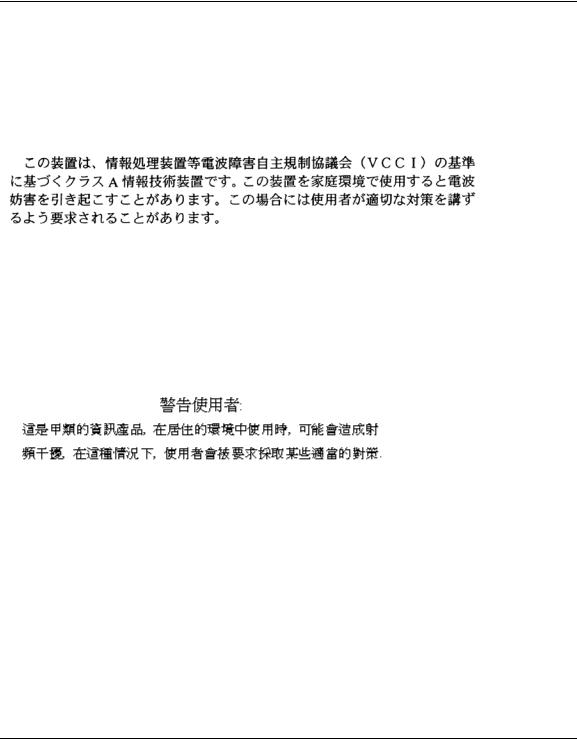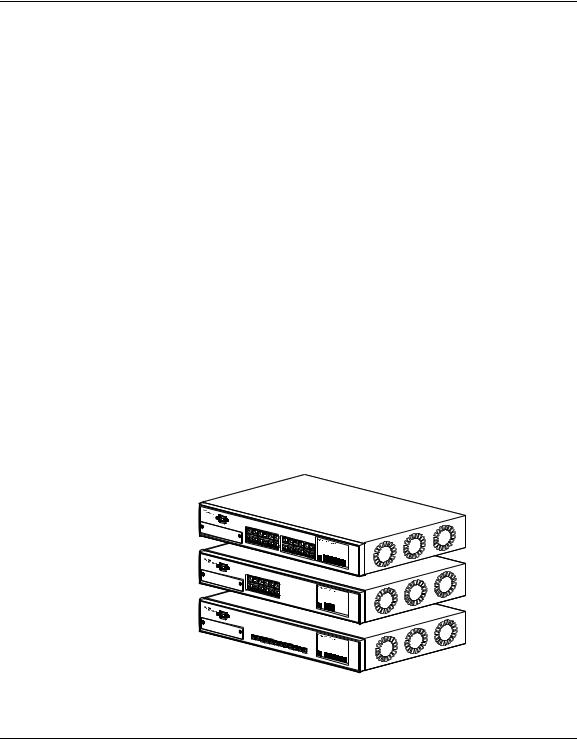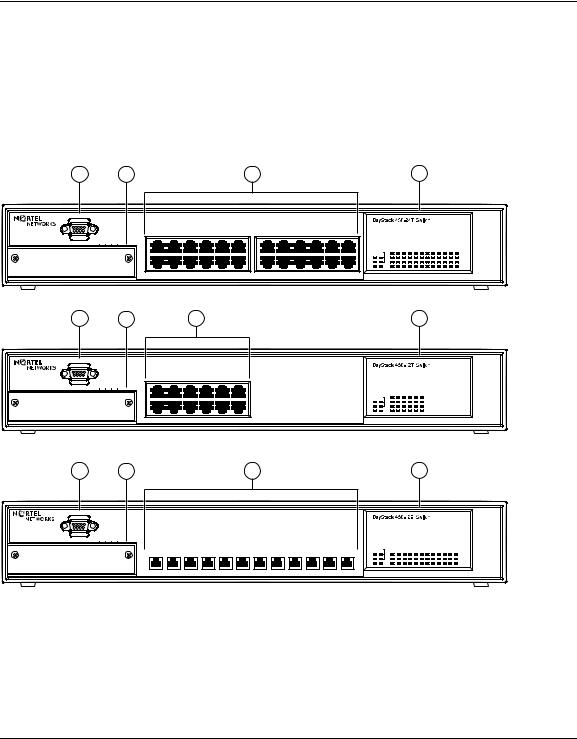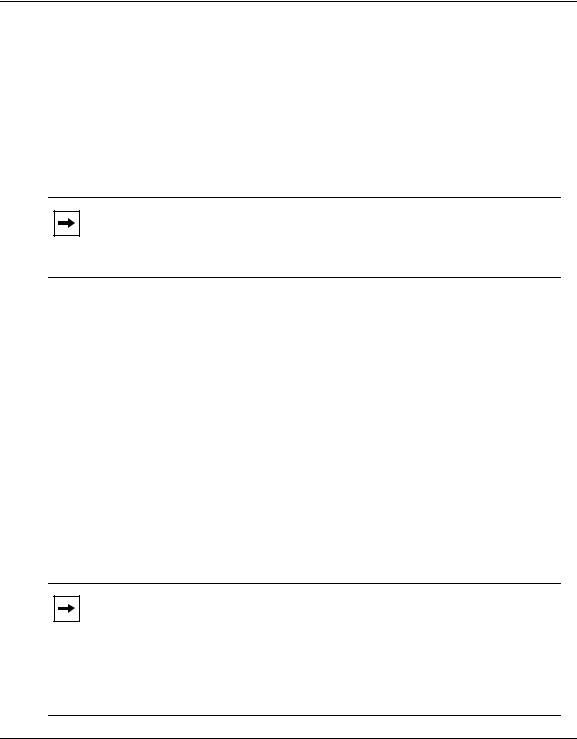Nortel Networks 450 User Manual

Software Release V1.3.0
Part No. 302401-D Rev 00
July 1999
4401 Great America Parkway
Santa Clara, CA 95054
Using the BayStack 450
10/100/1000 Series Switch

Copyright © 1999 Nortel Networks
All rights reserved. Printed in the USA. July 1999.
The information in this document is subject to change without notice. The statements, configurations, technical data, and recommendations in this document are believed to be accurate and reliable, but are presented without express or implied warranty. Users must take full responsibility for their applications of any products specified in this document. The information in this document is proprietary to Nortel Networks NA Inc.
Trademarks
NORTEL NETWORKS is a trademark of Nortel Networks Corporation.
Bay Networks and Optivity are registered trademarks and Accelar, BayStack, EZ LAN, Optivity Campus, Optivity Enterprise, StackProbe, and the Bay Networks logo are trademarks of Nortel Networks NA Inc.
Microsoft, MS, MS-DOS, Win32, Windows, and Windows NT are registered trademarks of Microsoft Corporation.
All other trademarks and registered trademarks are the property of their respective owners.
Statement of Conditions
In the interest of improving internal design, operational function, and/or reliability, Nortel Networks NA Inc. reserves the right to make changes to the products described in this document without notice.
Nortel Networks NA Inc. does not assume any liability that may occur due to the use or application of the product(s) or circuit layout(s) described herein.
USA Requirements Only
Federal Communications Commission (FCC) Compliance Notice: Radio Frequency Notice
Note: This equipment has been tested and found to comply with the limits for a Class A digital device, pursuant to Part 15 of the FCC rules. These limits are designed to provide reasonable protection against harmful interference when the equipment is operated in a commercial environment. This equipment generates, uses, and can radiate radio frequency energy. If it is not installed and used in accordance with the instruction manual, it may cause harmful interference to radio communications. Operation of this equipment in a residential area is likely to cause harmful interference, in which case users will be required to take whatever measures may be necessary to correct the interference at their own expense.
European Requirements Only
EN 55 022 Statement
This is to certify that the Nortel Networks BayStack 450 switch is shielded against the generation of radio interference in accordance with the application of Council Directive 89/336/EEC, Article 4a. Conformity is declared by the application of EN 55 022 Class A (CISPR 22).
Warning: This is a Class A product. In a domestic environment, this product may cause radio interference, in which case, the user may be required to take appropriate measures.
Achtung: Dieses ist ein Gerät der Funkstörgrenzwertklasse A. In Wohnbereichen können bei Betrieb dieses Gerätes Rundfunkstörungen auftreten, in welchen Fällen der Benutzer für entsprechende Gegenmaßnahmen verantwortlich ist.
Attention: Ceci est un produit de Classe A. Dans un environnement domestique, ce produit risque de créer des interférences radioélectriques, il appartiendra alors à l’utilisateur de prendre les mesures spécifiques appropriées.
ii |
302401-D Rev 00 |

EC Declaration of Conformity
This product conforms (or these products conform) to the provisions of Council Directive 89/336/EEC and 73/23/EEC. The Declaration of Conformity is available on the Nortel Networks World Wide Web site at http://libra2.corpwest.baynetworks.com/cgi-bin/ndCGI.exe/DocView/.
Japan/Nippon Requirements Only
Voluntary Control Council for Interference (VCCI) Statement
Voluntary Control Council for Interference (VCCI) Statement
This is a Class A product based on the standard of the Voluntary Control Council for Interference by Information Technology Equipment (VCCI). If this equipment is used in a domestic environment, radio disturbance may arise. When such trouble occurs, the user may be required to take corrective actions.
Taiwan Requirements
Bureau of Standards, Metrology and Inspection (BSMI) Statement
Canada Requirements Only
Canadian Department of Communications Radio Interference Regulations
This digital apparatus (BayStack 450 switch) does not exceed the Class A limits for radio-noise emissions from digital apparatus as set out in the Radio Interference Regulations of the Canadian Department of Communications.
Règlement sur le brouillage radioélectrique du ministère des Communications
Cet appareil numérique (BayStack 450 switch) respecte les limites de bruits radioélectriques visant les appareils numériques de classe A prescrites dans le Règlement sur le brouillage radioélectrique du ministère des Communications du Canada.
302401-D Rev 00 |
iii |

Nortel Networks NA Inc. Software License Agreement
NOTICE: Please carefully read this license agreement before copying or using the accompanying software or installing the hardware unit with pre-enabled software (each of which is referred to as “Software” in this Agreement). BY COPYING OR USING THE SOFTWARE, YOU ACCEPT ALL OF THE TERMS AND CONDITIONS OF THIS LICENSE AGREEMENT. THE TERMS EXPRESSED IN THIS AGREEMENT ARE THE ONLY TERMS UNDER WHICH NORTEL NETWORKS WILL PERMIT YOU TO USE THE SOFTWARE. If you do not accept these terms and conditions, return the product, unused and in the original shipping container, within 30 days of purchase to obtain a credit for the full purchase price.
1.License Grant. Nortel Networks NA Inc. (“Nortel Networks”) grants the end user of the Software (“Licensee”) a personal, nonexclusive, nontransferable license: a) to use the Software either on a single computer or, if applicable, on a single authorized device identified by host ID, for which it was originally acquired; b) to copy the Software solely for backup purposes in support of authorized use of the Software; and c) to use and copy the associated user manual solely in support of authorized use of the Software by Licensee. This license applies to the Software only and does not extend to Nortel Networks Agent software or other Nortel Networks software products. Nortel Networks Agent software or other Nortel Networks software products are licensed for use under the terms of the applicable Nortel Networks NA Inc. Software License Agreement that accompanies such software and upon payment by the end user of the applicable license fees for such software.
2.Restrictions on use; reservation of rights. The Software and user manuals are protected under copyright laws. Nortel Networks and/or its licensors retain all title and ownership in both the Software and user manuals, including any revisions made by Nortel Networks or its licensors. The copyright notice must be reproduced and included with any copy of any portion of the Software or user manuals. Licensee may not modify, translate, decompile, disassemble, use for any competitive analysis, reverse engineer, distribute, or create derivative works from the Software or user manuals or any copy, in whole or in part. Except as expressly provided in this Agreement, Licensee may not copy or transfer the Software or user manuals, in whole or in part. The Software and user manuals embody Nortel Networks’ and its licensors’ confidential and proprietary intellectual property. Licensee shall not sublicense, assign, or otherwise disclose to any third party the Software, or any information about the operation, design, performance, or implementation of the Software and user manuals that is confidential to Nortel Networks and its licensors; however, Licensee may grant permission to its consultants, subcontractors, and agents to use the Software at Licensee’s facility, provided they have agreed to use the Software only in accordance with the terms of this license.
3.Limited warranty. Nortel Networks warrants each item of Software, as delivered by Nortel Networks and properly installed and operated on Nortel Networks hardware or other equipment it is originally licensed for, to function substantially as described in its accompanying user manual during its warranty period, which begins on the date Software is first shipped to Licensee. If any item of Software fails to so function during its warranty period, as the sole remedy Nortel Networks will at its discretion provide a suitable fix, patch, or workaround for the problem that may be included in a future Software release. Nortel Networks further warrants to Licensee that the media on which the Software is provided will be free from defects in materials and workmanship under normal use for a period of 90 days from the date Software is first shipped to Licensee. Nortel Networks will replace defective media at no charge if it is returned to Nortel Networks during the warranty period along with proof of the date of shipment. This warranty does not apply if the media has been damaged as a result of accident, misuse, or abuse. The Licensee assumes all responsibility for selection of the Software to achieve Licensee’s intended results and for the installation, use, and results obtained from the Software. Nortel Networks does not warrant a) that the functions contained in the software will meet the Licensee’s requirements, b) that the Software will operate in the hardware or software combinations that the Licensee may select, c) that the operation of the Software will be uninterrupted or error free, or d) that all defects in the operation of the Software will be corrected. Nortel Networks is not obligated to remedy any Software defect that cannot be reproduced with the latest Software release. These warranties do not apply to the Software if it has been (i) altered, except by Nortel Networks or in accordance with its instructions; (ii) used in conjunction with another vendor’s product, resulting in the defect; or (iii) damaged by improper environment, abuse, misuse, accident, or negligence. THE FOREGOING WARRANTIES AND LIMITATIONS ARE EXCLUSIVE REMEDIES AND ARE IN LIEU OF ALL OTHER WARRANTIES EXPRESS OR IMPLIED, INCLUDING WITHOUT LIMITATION ANY WARRANTY OF MERCHANTABILITY OR FITNESS FOR A PARTICULAR PURPOSE.
iv |
302401-D Rev 00 |

Licensee is responsible for the security of its own data and information and for maintaining adequate procedures apart from the Software to reconstruct lost or altered files, data, or programs.
4.Limitation of liability. IN NO EVENT WILL NORTEL NETWORKS OR ITS LICENSORS BE LIABLE FOR ANY COST OF SUBSTITUTE PROCUREMENT; SPECIAL, INDIRECT, INCIDENTAL, OR CONSEQUENTIAL DAMAGES; OR ANY DAMAGES RESULTING FROM INACCURATE OR LOST DATA OR LOSS OF USE OR PROFITS ARISING OUT OF OR IN CONNECTION WITH THE PERFORMANCE OF THE SOFTWARE, EVEN IF NORTEL NETWORKS HAS BEEN ADVISED OF THE POSSIBILITY OF SUCH DAMAGES. IN NO EVENT SHALL THE LIABILITY OF NORTEL NETWORKS RELATING TO THE SOFTWARE OR THIS AGREEMENT EXCEED THE PRICE PAID TO NORTEL NETWORKS FOR THE SOFTWARE LICENSE.
5.Government Licensees. This provision applies to all Software and documentation acquired directly or indirectly by or on behalf of the United States Government. The Software and documentation are commercial products, licensed on the open market at market prices, and were developed entirely at private expense and without the use of any U.S.
Government funds. The license to the U.S. Government is granted only with restricted rights, and use, duplication, or disclosure by the U.S. Government is subject to the restrictions set forth in subparagraph (c)(1) of the Commercial Computer Software––Restricted Rights clause of FAR 52.227-19 and the limitations set out in this license for civilian agencies, and subparagraph (c)(1)(ii) of the Rights in Technical Data and Computer Software clause of DFARS 252.227-7013, for agencies of the Department of Defense or their successors, whichever is applicable.
6.Use of Software in the European Community. This provision applies to all Software acquired for use within the European Community. If Licensee uses the Software within a country in the European Community, the Software Directive enacted by the Council of European Communities Directive dated 14 May, 1991, will apply to the examination of the Software to facilitate interoperability. Licensee agrees to notify Nortel Networks of any such intended examination of the Software and may procure support and assistance from Nortel Networks.
7.Term and termination. This license is effective until terminated; however, all of the restrictions with respect to Nortel Networks’ copyright in the Software and user manuals will cease being effective at the date of expiration of the Nortel Networks copyright; those restrictions relating to use and disclosure of Nortel Networks’ confidential information shall continue in effect. Licensee may terminate this license at any time. The license will automatically terminate if Licensee fails to comply with any of the terms and conditions of the license. Upon termination for any reason, Licensee will immediately destroy or return to Nortel Networks the Software, user manuals, and all copies. Nortel Networks is not liable to Licensee for damages in any form solely by reason of the termination of this license.
8.Export and Re-export. Licensee agrees not to export, directly or indirectly, the Software or related technical data or information without first obtaining any required export licenses or other governmental approvals. Without limiting the foregoing, Licensee, on behalf of itself and its subsidiaries and affiliates, agrees that it will not, without first obtaining all export licenses and approvals required by the U.S. Government: (i) export, re-export, transfer, or divert any such Software or technical data, or any direct product thereof, to any country to which such exports or re-exports are restricted or embargoed under United States export control laws and regulations, or to any national or resident of such restricted or embargoed countries; or (ii) provide the Software or related technical data or information to any military end user or for any military end use, including the design, development, or production of any chemical, nuclear, or biological weapons.
9.General. If any provision of this Agreement is held to be invalid or unenforceable by a court of competent jurisdiction, the remainder of the provisions of this Agreement shall remain in full force and effect. This Agreement will be governed by the laws of the state of California.
Should you have any questions concerning this Agreement, contact Nortel Networks, 4401 Great America Parkway, P.O. Box 58185, Santa Clara, California 95054-8185.
LICENSEE ACKNOWLEDGES THAT LICENSEE HAS READ THIS AGREEMENT, UNDERSTANDS IT, AND AGREES TO BE BOUND BY ITS TERMS AND CONDITIONS. LICENSEE FURTHER AGREES THAT THIS AGREEMENT IS THE ENTIRE AND EXCLUSIVE AGREEMENT BETWEEN NORTEL NETWORKS AND LICENSEE, WHICH SUPERSEDES ALL PRIOR ORAL AND WRITTEN AGREEMENTS AND COMMUNICATIONS BETWEEN THE PARTIES PERTAINING TO THE SUBJECT MATTER OF THIS AGREEMENT. NO DIFFERENT OR ADDITIONAL TERMS WILL BE ENFORCEABLE AGAINST NORTEL NETWORKS UNLESS NORTEL NETWORKS GIVES ITS EXPRESS WRITTEN CONSENT, INCLUDING AN EXPRESS WAIVER OF THE TERMS OF THIS AGREEMENT.
302401-D Rev 00 |
v |

Contents
Preface |
|
Audience .......................................................................................................................... |
xxi |
Organization ................................................................................................................... |
xxii |
Text Conventions ........................................................................................................... |
xxiii |
Acronyms ....................................................................................................................... |
xxiii |
Related Publications ...................................................................................................... |
xxiv |
How to Get Help ............................................................................................................. |
xxv |
Chapter 1 |
|
BayStack 450 10/100/1000 Series Switches |
|
Physical Description ....................................................................................................... |
1-1 |
Front Panel ............................................................................................................... |
1-2 |
Comm Port ........................................................................................................ |
1-3 |
Uplink/Expansion Slot ........................................................................................ |
1-3 |
Port Connectors ................................................................................................. |
1-3 |
LED Display Panel ............................................................................................. |
1-5 |
Back Panel ............................................................................................................... |
1-8 |
AC Power Receptacle ........................................................................................ |
1-9 |
RPSU Connector ............................................................................................. |
1-10 |
Cascade Module Slot ...................................................................................... |
1-11 |
Cooling Fans .................................................................................................... |
1-11 |
Features ........................................................................................................................ |
1-11 |
IEEE 802.1p Prioritizing ......................................................................................... |
1-14 |
IEEE 802.1Q VLANs .............................................................................................. |
1-14 |
IGMP Snooping Feature ........................................................................................ |
1-15 |
Flash Memory Storage ........................................................................................... |
1-15 |
Storage of Switch Software Image .................................................................. |
1-15 |
Storage of Configuration Parameters .............................................................. |
1-15 |
MultiLink Trunking .................................................................................................. |
1-16 |
302401-D Rev 00 |
vii |
|
.........................................................................................................Port Mirroring |
1-16 |
|
Autosensing and Autonegotiation ........................................................................... |
1-16 |
|
BootP Automatic IP Configuration/MAC Address ................................................... |
1-17 |
|
SNMP MIB Support ................................................................................................ |
1-18 |
|
Configuration and Switch Management ................................................................. |
1-18 |
|
Network Configuration .................................................................................................. |
1-18 |
|
Desktop Switch Application .................................................................................... |
1-19 |
|
Segment Switch Application ................................................................................... |
1-20 |
|
High-Density Switched Workgroup Application ...................................................... |
1-21 |
|
Fail-Safe Stack Application ..................................................................................... |
1-22 |
|
Stack Operation ............................................................................................................ |
1-23 |
|
BayStack 400-ST1 Cascade Module ..................................................................... |
1-23 |
|
Cascade A Out Connector ............................................................................... |
1-24 |
|
Unit Select Switch ............................................................................................ |
1-24 |
|
Cascade A In Connector ................................................................................. |
1-24 |
|
Base Unit ................................................................................................................ |
1-25 |
|
Initial Installation .............................................................................................. |
1-25 |
|
Stack MAC Address ......................................................................................... |
1-26 |
|
Temporary Base Unit ....................................................................................... |
1-26 |
|
Removing a Unit from the Stack ...................................................................... |
1-27 |
|
Stack Configurations .............................................................................................. |
1-27 |
|
Stack Up Configurations .................................................................................. |
1-28 |
|
Stack Down Configurations ............................................................................. |
1-28 |
|
Redundant Cascade Stacking Feature .................................................................. |
1-30 |
|
IEEE 802.1Q VLAN Workgroups .................................................................................. |
1-32 |
|
IEEE 802.1Q Tagging ............................................................................................. |
1-33 |
|
VLANs Spanning Multiple Switches ....................................................................... |
1-37 |
|
VLANS Spanning Multiple 802.1Q Tagged Switches ...................................... |
1-37 |
|
VLANS Spanning Multiple Untagged Switches ............................................... |
1-38 |
|
Shared Servers ...................................................................................................... |
1-40 |
|
VLAN Workgroup Summary ................................................................................... |
1-45 |
|
VLAN Configuration Rules ..................................................................................... |
1-47 |
|
IGMP Snooping ............................................................................................................ |
1-48 |
|
IGMP Snooping Configuration Rules ..................................................................... |
1-52 |
|
IEEE 802.1p Prioritizing ............................................................................................... |
1-53 |
|
viii |
302401-D Rev 00 |
|
|
|

MultiLink Trunks ............................................................................................................ |
1-57 |
Client/Server Configuration Using MultiLink Trunks ............................................... |
1-58 |
Trunk Configuration Screen Examples ................................................................... |
1-60 |
Trunk Configuration Screen for Switch S1 ....................................................... |
1-60 |
Trunk Configuration Screen for Switch S2 ....................................................... |
1-63 |
Trunk Configuration Screen for Switch S3 ....................................................... |
1-65 |
Trunk Configuration Screen for Switch S4 ....................................................... |
1-67 |
Before Configuring Trunks ...................................................................................... |
1-69 |
MultiLink Trunking Configuration Rules .................................................................. |
1-69 |
How the MultiLink Trunk Reacts to Losing Distributed Trunk Members ................. |
1-71 |
Spanning Tree Considerations for MultiLink Trunks ............................................... |
1-72 |
Additional Tips About the MultiLink Trunking Feature ............................................ |
1-75 |
Port Mirroring (Conversation Steering) ......................................................................... |
1-76 |
Port-Based Mirroring Configuration ........................................................................ |
1-77 |
Address-Based Mirroring Configuration ................................................................. |
1-79 |
Port Mirroring Configuration Rules ......................................................................... |
1-82 |
Chapter 2 |
|
Installing the BayStack 450 Switch |
|
Installation Requirements ............................................................................................... |
2-1 |
Installation Procedure ..................................................................................................... |
2-3 |
Installing the BayStack 450 Switch on a Flat Surface .............................................. |
2-3 |
Installing the BayStack 450 Switch in a Rack .......................................................... |
2-4 |
Attaching Devices to the BayStack 450 Switch ........................................................ |
2-7 |
Connecting the 10BASE-T/100BASE-TX Ports ................................................. |
2-8 |
Connecting Fiber Optic Ports ............................................................................ |
2-9 |
Console/Comm Port ........................................................................................ |
2-10 |
Connecting a Terminal to the Console/Comm Port .......................................... |
2-11 |
Connecting Power ......................................................................................................... |
2-12 |
Verifying the Installation ................................................................................................ |
2-14 |
Verifying the Installation Using the LEDs ............................................................... |
2-14 |
Verifying the Installation Using the Self-Test Screen .............................................. |
2-15 |
Initial Setup ................................................................................................................... |
2-17 |
Standalone Switch Setup ....................................................................................... |
2-17 |
Stack Setup ............................................................................................................ |
2-20 |
302401-D Rev 00 |
ix |

Chapter 3
Using the Console Interface
Accessing the CI Menus and Screens ............................................................................ |
3-1 |
Using the CI Menus and Screens ................................................................................... |
3-2 |
Navigating the CI Menus and Screens ..................................................................... |
3-2 |
Screen Fields and Descriptions ............................................................................... |
3-3 |
Main Menu ...................................................................................................................... |
3-4 |
IP Configuration/Setup ................................................................................................... |
3-8 |
Choosing a BootP Request Mode ................................................................................ |
3-10 |
BootP When Needed ............................................................................................. |
3-10 |
BootP Always ......................................................................................................... |
3-11 |
BootP Disabled ...................................................................................................... |
3-11 |
BootP or Last Address ........................................................................................... |
3-12 |
SNMP Configuration ..................................................................................................... |
3-13 |
System Characteristics ................................................................................................. |
3-15 |
Switch Configuration ..................................................................................................... |
3-18 |
MAC Address Table ................................................................................................ |
3-20 |
VLAN Configuration Menu ..................................................................................... |
3-22 |
VLAN Configuration ......................................................................................... |
3-24 |
VLAN Port Configuration ................................................................................. |
3-26 |
VLAN Display by Port ...................................................................................... |
3-29 |
Traffic Class Configuration ............................................................................... |
3-30 |
Port Configuration .................................................................................................. |
3-32 |
High Speed Flow Control Configuration ................................................................. |
3-34 |
Choosing a High Speed Flow Control Mode .......................................................... |
3-36 |
Symmetric Mode .............................................................................................. |
3-36 |
Asymmetric ...................................................................................................... |
3-37 |
MultiLink Trunk Configuration ................................................................................. |
3-37 |
MultiLink Trunk Configuration Screen .............................................................. |
3-39 |
MultiLink Trunk Utilization Screen .................................................................... |
3-41 |
Port Mirroring Configuration ................................................................................... |
3-45 |
Rate Limiting Configuration .................................................................................... |
3-48 |
IGMP Configuration ................................................................................................ |
3-51 |
Port Statistics ......................................................................................................... |
3-54 |
Console/Comm Port Configuration ............................................................................... |
3-58 |
x |
302401-D Rev 00 |

Renumber Stack Units .................................................................................................. |
3-65 |
Hardware Unit Information ............................................................................................ |
3-67 |
Spanning Tree Configuration ........................................................................................ |
3-67 |
Spanning Tree Port Configuration .......................................................................... |
3-69 |
Display Spanning Tree Switch Settings .................................................................. |
3-72 |
TELNET Configuration ................................................................................................. |
3-75 |
Software Download ....................................................................................................... |
3-78 |
Configuration File ......................................................................................................... |
3-82 |
Display Event Log ......................................................................................................... |
3-85 |
Excessive Bad Entries ........................................................................................... |
3-86 |
Write Threshold ...................................................................................................... |
3-86 |
Flash Update .......................................................................................................... |
3-87 |
Reset ............................................................................................................................ |
3-88 |
Reset to Default Settings .............................................................................................. |
3-90 |
Logout ........................................................................................................................... |
3-93 |
Chapter 4 |
|
Troubleshooting |
|
Interpreting the LEDs ..................................................................................................... |
4-2 |
Diagnosing and Correcting the Problem ......................................................................... |
4-5 |
Normal Power-Up Sequence .................................................................................... |
4-6 |
Port Connection Problems ....................................................................................... |
4-7 |
Autonegotiation Modes ...................................................................................... |
4-8 |
Port Interface ..................................................................................................... |
4-9 |
Appendix A |
|
Technical Specifications |
|
Environmental ................................................................................................................ |
A-1 |
Electrical ........................................................................................................................ |
A-1 |
Physical Dimensions ...................................................................................................... |
A-2 |
Performance Specifications ........................................................................................... |
A-2 |
Network Protocol and Standards Compatibility ............................................................. |
A-2 |
Data Rate ...................................................................................................................... |
A-2 |
Interface Options ........................................................................................................... |
A-3 |
Safety Agency Certification ........................................................................................... |
A-3 |
Electromagnetic Emissions ........................................................................................... |
A-3 |
302401-D Rev 00 |
xi |
|
.............................................................................................Electromagnetic Immunity |
A-3 |
|
Declaration of Conformity .............................................................................................. |
A-4 |
|
Appendix B |
|
|
Gigabit Fiber Optical Characteristics |
|
|
1000BASE-SX Models .................................................................................................. |
B-1 |
|
Operating Range ..................................................................................................... |
B-1 |
|
Transmit Characteristics .......................................................................................... |
B-2 |
|
Receive Characteristics .......................................................................................... |
B-3 |
|
Worst-Case Power Budget and Penalties ............................................................... |
B-3 |
|
1000BASE-LX Models ................................................................................................... |
B-4 |
|
Operating Range ..................................................................................................... |
B-4 |
|
Transmit Characteristics .......................................................................................... |
B-5 |
|
Receive Characteristics .......................................................................................... |
B-5 |
|
Worst-Case Power Budget and Penalties ............................................................... |
B-6 |
|
Appendix C |
|
|
Media Dependent Adapters |
|
|
10BASE-T/100BASE-TX MDA ...................................................................................... |
C-2 |
|
100BASE-FX MDAs ....................................................................................................... |
C-3 |
|
1000BASE-SX MDAs .................................................................................................... |
C-6 |
|
M1000BASE-LX MDAs .................................................................................................. |
C-9 |
|
Installing an MDA ......................................................................................................... |
C-11 |
|
Replacing an MDA with a Different Model ................................................................... |
C-13 |
|
1000BASE-LX Multimode Applications ....................................................................... |
C-13 |
|
Appendix D |
|
|
Quick Steps to Features |
|
|
Configuring 802.1Q VLANs ........................................................................................... |
D-2 |
|
Configuring MultiLink Trunks ......................................................................................... |
D-4 |
|
Configuring Port Mirroring ............................................................................................. |
D-5 |
|
Configuring IGMP Snooping .......................................................................................... |
D-7 |
|
Appendix E |
|
|
Connectors and Pin Assignments |
|
|
RJ-45 (10BASE-T/100BASE-TX) Port Connectors ....................................................... |
E-1 |
|
MDI and MDI-X Devices ................................................................................................ |
E-2 |
|
MDI-X to MDI Cable Connections ........................................................................... |
E-3 |
|
xii |
302401-D Rev 00 |
|
|
|

MDI-X to MDI-X Cable Connections ....................................................................... |
E-4 |
DB-9 (RS-232-D) Console/Comm Port Connector ........................................................ |
E-5 |
Appendix F
Default Settings
Appendix G
Sample BootP Configuration File
Index
302401-D Rev 00 |
xiii |

Figures
Figure 1-1. |
BayStack 450 Switch Versions ................................................................. |
1-1 |
Figure 1-2. |
BayStack 450 Switch Front Panels .......................................................... |
1-2 |
Figure 1-3. |
BayStack 450-24T/12T LED Display Panel .............................................. |
1-5 |
Figure 1-4. |
BayStack 450-12F LED Display Panel ..................................................... |
1-6 |
Figure 1-5. |
BayStack 450 Switch Back Panel ............................................................ |
1-9 |
Figure 1-6. BayStack 450 Switch Used as a Desktop Switch .................................. |
1-19 |
|
Figure 1-7. |
BayStack 450 Switch Used as a Segment Switch ................................. |
1-20 |
Figure 1-8. |
Configuring Power Workgroups and a Shared Media Hub .................... |
1-21 |
Figure 1-9. |
Fail-Safe Stack Example ........................................................................ |
1-22 |
Figure 1-10. |
BayStack 400-ST1 Front-Panel Components ........................................ |
1-23 |
Figure 1-11. |
Connecting Cascade Cables ................................................................. |
1-24 |
Figure 1-12. |
Stack Up Configuration Example ........................................................... |
1-28 |
Figure 1-13. |
Stack Down Configuration Example ....................................................... |
1-29 |
Figure 1-14. Redundant Cascade Stacking Feature .................................................. |
1-31 |
|
Figure 1-15. |
Port-Based VLAN Example .................................................................... |
1-32 |
Figure 1-16. |
Default VLAN Settings ........................................................................... |
1-34 |
Figure 1-17. |
802.1Q Tagging (1 of 4) ......................................................................... |
1-35 |
Figure 1-18. |
802.1Q Tagging (2 of 4) ......................................................................... |
1-35 |
Figure 1-19. |
802.1Q Tagging (3 of 4) ......................................................................... |
1-36 |
Figure 1-20. |
802.1Q Tagging (4 of 4) ......................................................................... |
1-36 |
Figure 1-21. |
VLANs Spanning Multiple 802.1Q Tagged Switches ............................. |
1-37 |
Figure 1-22. VLANs Spanning Multiple Untagged Switches ...................................... |
1-38 |
|
Figure 1-23. |
Possible Problems with VLANs and Spanning Tree Protocol ................. |
1-39 |
Figure 1-24. |
Multiple VLANs Sharing Resources ....................................................... |
1-40 |
Figure 1-25. VLAN Broadcast Domains Within the Switch ......................................... |
1-41 |
|
Figure 1-26. |
Default VLAN Configuration Screen Example ........................................ |
1-42 |
Figure 1-27. |
VLAN Configuration Screen Example .................................................... |
1-43 |
Figure 1-28. |
Default VLAN Port Configuration Screen Example ................................ |
1-44 |
Figure 1-29. |
VLAN Port Configuration Screen Example ............................................ |
1-45 |
302401-D Rev 00 |
xv |
|
Figure 1-30. |
..................................VLAN Configuration Spanning Multiple Switches |
1-46 |
|
Figure 1-31. |
IP Multicast Propagation With IGMP Routing ........................................ |
1-49 |
|
Figure 1-32. |
BayStack 450 Switch Filtering IP Multicast Streams (1 of 2) ................. |
1-50 |
|
Figure 1-33. |
BayStack 450 Switch Filtering IP Multicast Streams (2 of 2) ................. |
1-51 |
|
Figure 1-34. |
Prioritizing Packets ................................................................................. |
1-53 |
|
Figure 1-35. |
Port Transmit Queue .............................................................................. |
1-54 |
|
Figure 1-36. |
Default Traffic Class Configuration Screen Example ............................. |
1-55 |
|
Figure 1-37. |
Setting Port Priority Example ................................................................. |
1-56 |
|
Figure 1-38. |
Switch-to-Switch Trunk Configuration Example ..................................... |
1-57 |
|
Figure 1-39. |
Switch-to-Server Trunk Configuration Example ..................................... |
1-58 |
|
Figure 1-40. |
Client/Server Configuration Example ..................................................... |
1-59 |
|
Figure 1-41. |
Choosing the MultiLink Trunk Configuration Screen .............................. |
1-60 |
|
Figure 1-42. |
MultiLink Trunk Configuration Screen for Switch S1 .............................. |
1-61 |
|
Figure 1-43. |
MultiLink Trunk Configuration Screen for Switch S2 .............................. |
1-63 |
|
Figure 1-44. |
MultiLink Trunk Configuration Screen for Switch S3 .............................. |
1-65 |
|
Figure 1-45. |
MultiLink Trunk Configuration Screen for Switch S4 .............................. |
1-67 |
|
Figure 1-46. |
Loss of Distributed Trunk Members ....................................................... |
1-71 |
|
Figure 1-47. |
Path Cost Arbitration Example ............................................................... |
1-72 |
|
Figure 1-48. |
Example 1: Correctly Configured Trunk ................................................. |
1-73 |
|
Figure 1-49. |
Example 2: Detecting a Misconfigured Port ........................................... |
1-74 |
|
Figure 1-50. |
Port-Based Mirroring Configuration Example ........................................ |
1-77 |
|
Figure 1-51. |
Port Mirroring Port-Based Screen Example ........................................... |
1-79 |
|
Figure 1-52. |
Address-Based Mirroring Configuration Example .................................. |
1-80 |
|
Figure 1-53. |
Port Mirroring Address-Based Screen Example .................................... |
1-81 |
|
Figure 2-1. |
Package Contents .................................................................................... |
2-2 |
|
Figure 2-2. |
Positioning the Chassis in the Rack ......................................................... |
2-5 |
|
Figure 2-3. |
Attaching Mounting Brackets ................................................................... |
2-6 |
|
Figure 2-4. |
Installing the BayStack 450 Switch in an Equipment Rack ...................... |
2-6 |
|
Figure 2-5. 10/100 Mb/s Port Connections ................................................................. |
2-8 |
|
|
Figure 2-6. |
Fiber Optic Port Connections ................................................................... |
2-9 |
|
Figure 2-7. |
Connecting to the Console/Comm Port ................................................. |
2-11 |
|
Figure 2-8. |
BayStack 450 Switch AC Power Receptacle .......................................... |
2-13 |
|
Figure 2-9. |
Grounded AC Power Outlet .................................................................... |
2-13 |
|
Figure 2-10. |
Observing LEDs to Verify Proper Operation .......................................... |
2-14 |
|
Figure 2-11. |
BayStack 450 Switch Self-Test Screen .................................................. |
2-15 |
|
xvi |
|
302401-D Rev 00 |
|
|
|
|

Figure 2-12. |
Nortel Networks Logo Screen ................................................................ |
2-16 |
Figure 2-13. |
Main Menu ............................................................................................. |
2-18 |
Figure 2-14. |
IP Configuration/Setup Screen (Standalone Switch) ............................. |
2-19 |
Figure 2-15. |
Main Menu (Standalone Switch Example) ............................................. |
2-21 |
Figure 2-16. |
Main Menu (Stack Configuration Example) ............................................ |
2-21 |
Figure 2-17. |
IP Configuration/Setup Screen (Stack Configuration) ............................ |
2-22 |
Figure 3-1. |
Map of Console Interface Screens ........................................................... |
3-3 |
Figure 3-2. |
Console Interface Main Menu .................................................................. |
3-4 |
Figure 3-3. |
IP Configuration/Setup Screen ................................................................ |
3-8 |
Figure 3-4. |
SNMP Configuration Screen .................................................................. |
3-13 |
Figure 3-5. |
System Characteristics Screen .............................................................. |
3-15 |
Figure 3-6. Switch Configuration Menu Screen ........................................................ |
3-18 |
|
Figure 3-7. |
MAC Address Table Screen ................................................................... |
3-21 |
Figure 3-8. |
VLAN Configuration Menu Screen ......................................................... |
3-23 |
Figure 3-9. |
VLAN Configuration Screen ................................................................... |
3-24 |
Figure 3-10. |
VLAN Port Configuration Screen ........................................................... |
3-27 |
Figure 3-11. |
VLAN Display by Port Screen ................................................................ |
3-29 |
Figure 3-12. Traffic Class Configuration Screen ......................................................... |
3-31 |
|
Figure 3-13. |
Port Configuration Screen (1 of 2) ......................................................... |
3-32 |
Figure 3-14. |
Port Configuration Screen (2 of 2) ......................................................... |
3-33 |
Figure 3-15. |
High Speed Flow Control Configuration Screen .................................... |
3-35 |
Figure 3-16. |
MultiLink Trunk Configuration Menu Screen .......................................... |
3-38 |
Figure 3-17. |
MultiLink Trunk Configuration Screen .................................................... |
3-40 |
Figure 3-18. |
MultiLink Trunk Utilization Screen (1 of 2) .............................................. |
3-42 |
Figure 3-19. |
MultiLink Trunk Utilization Screen (2 of 2) .............................................. |
3-43 |
Figure 3-20. |
Port Mirroring Configuration Screen ...................................................... |
3-45 |
Figure 3-21. |
Rate Limiting Configuration Screen (1 of 2) ........................................... |
3-48 |
Figure 3-22. |
Rate Limiting Configuration Screen (2 of 2) ........................................... |
3-49 |
Figure 3-23. |
IGMP Configuration Screen ................................................................... |
3-51 |
Figure 3-24. |
Port Statistics Screen ............................................................................. |
3-54 |
Figure 3-25. |
Console/Comm Port Configuration Screen ............................................ |
3-58 |
Figure 3-26. Renumber Stack Units Screen ............................................................... |
3-65 |
|
Figure 3-27. |
Hardware Unit Information Screen ......................................................... |
3-67 |
Figure 3-28. |
Spanning Tree Configuration Menu Screen ........................................... |
3-68 |
Figure 3-29. |
Spanning Tree Port Configuration Screen (1 of 2) ................................. |
3-69 |
302401-D Rev 00 |
xvii |

Figure 3-30. |
Spanning Tree Port Configuration Screen (2 of 2) ................................. |
3-70 |
Figure 3-31. |
Spanning Tree Switch Settings Screen .................................................. |
3-72 |
Figure 3-32. |
TELNET Configuration Screen .............................................................. |
3-75 |
Figure 3-33. |
Software Download Screen ................................................................... |
3-79 |
Figure 3-34. |
Configuration File Download/Upload Screen ......................................... |
3-82 |
Figure 3-35. Event Log Screen .................................................................................. |
3-85 |
|
Figure 3-36. Sample Event Log Entry Showing Excessive Bad Entries ..................... |
3-86 |
|
Figure 3-37. Sample Event Log Entry Exceeding the Write Threshold ...................... |
3-87 |
|
Figure 3-38. |
Sample Event Log Entry Showing Flash Update Status ........................ |
3-87 |
Figure 3-39. Self-Test Screen After Resetting the Switch .......................................... |
3-88 |
|
Figure 3-40. Nortel Networks Logo Screen ................................................................ |
3-89 |
|
Figure 3-41. Self-Test Screen After Resetting to Default Settings .............................. |
3-91 |
|
Figure 3-42. |
Nortel Networks Logo Screen After Resetting to Default Settings ......... |
3-92 |
Figure 3-43. |
Password Prompt Screen ...................................................................... |
3-93 |
Figure 4-1. |
BayStack 450-24T/12T LED Display Panel .............................................. |
4-2 |
Figure 4-2. |
BayStack 450-12F LED Display Panel ..................................................... |
4-3 |
Figure C-1. |
400-4TX MDA Front Panel ...................................................................... |
C-2 |
Figure C-2. |
100BASE-FX MDA Front Panels ............................................................. |
C-4 |
Figure C-3. |
1000BASE-SX MDA Front Panels .......................................................... |
C-7 |
Figure C-4. |
1000BASE-LX MDA Front Panels ......................................................... |
C-10 |
Figure C-5. |
Installing an MDA .................................................................................. |
C-12 |
Figure D-1. |
Configuring 802.1Q VLANs (1 of 2) ........................................................ |
D-2 |
Figure D-2. |
Configuring 802.1Q VLANs (2 of 2) ........................................................ |
D-3 |
Figure D-3. |
Configuring MultiLink Trunks ................................................................... |
D-4 |
Figure D-4. |
Configuring Port Mirroring (1 of 2) .......................................................... |
D-5 |
Figure D-5. |
Configuring Port Mirroring (2 of 2) .......................................................... |
D-6 |
Figure D-6. |
Configuring IGMP Snooping (1 of 3) ....................................................... |
D-7 |
Figure D-7. |
Configuring IGMP Snooping (2 of 3) ....................................................... |
D-8 |
Figure D-8. |
Configuring IGMP Snooping (3 of 3) ....................................................... |
D-9 |
Figure E-1. |
RJ-45 (8-Pin Modular) Port Connector ................................................... |
E-1 |
Figure E-2. |
MDI-X to MDI Cable Connections ........................................................... |
E-3 |
Figure E-3. |
MDI-X to MDI-X Cable Connections ....................................................... |
E-4 |
Figure E-4. |
DB-9 Console/Comm Port Connector ..................................................... |
E-5 |
xviii |
302401-D Rev 00 |

Tables
Table 1-1. |
BayStack 450 Switch LED Descriptions ................................................. |
1-6 |
Table 1-2. |
International Power Cord Specifications .................................................. |
1-9 |
Table 2-1. |
Power-Up Sequence .............................................................................. |
2-14 |
Table 3-1. |
Console Interface Main Menu options ..................................................... |
3-5 |
Table 3-2. |
IP Configuration/Setup Screen Fields ..................................................... |
3-9 |
Table 3-3. |
SNMP Configuration Screen Fields ...................................................... |
3-13 |
Table 3-4. |
System Characteristics Screen Fields .................................................. |
3-16 |
Table 3-5. |
Switch Configuration Menu Screen Options ......................................... |
3-19 |
Table 3-6. |
MAC Address Table Screen Fields ....................................................... |
3-21 |
Table 3-7. |
VLAN Configuration Menu Screen Options ........................................... |
3-23 |
Table 3-8. |
VLAN Configuration Screen Fields ....................................................... |
3-25 |
Table 3-9. |
VLAN Port Configuration Screen Fields ................................................ |
3-27 |
Table 3-10. |
VLAN Display by Port Screen Fields ..................................................... |
3-30 |
Table 3-11. |
Traffic Class Configuration Screen Fields .............................................. |
3-31 |
Table 3-12. |
Port Configuration Screen Fields .......................................................... |
3-33 |
Table 3-13. |
High Speed Flow Control Configuration Screen Fields ......................... |
3-35 |
Table 3-14. |
MultiLink Trunk Configuration Menu Screen Options ............................. |
3-38 |
Table 3-15. |
MultiLink Trunk Configuration Screen Fields ......................................... |
3-40 |
Table 3-16. |
MultiLink Trunk Utilization Screen Fields .............................................. |
3-43 |
Table 3-17. |
Port Mirroring Configuration Screen Fields ........................................... |
3-46 |
Table 3-18. |
Monitoring Modes .................................................................................. |
3-47 |
Table 3-19. |
Rate Limiting Configuration Screen Fields ............................................. |
3-50 |
Table 3-20. |
IGMP Configuration Screen Fields ....................................................... |
3-52 |
Table 3-21. |
Port Statistics Screen Fields ................................................................. |
3-55 |
Table 3-22. |
Console/Comm Port Configuration Screen Fields ................................ |
3-58 |
Table 3-23. |
Renumber Stack Units Screen Options ................................................ |
3-66 |
Table 3-24. |
Spanning Tree Configuration Menu Screen Options ............................. |
3-68 |
Table 3-25. |
Spanning Tree Port Configuration Screen Fields .................................. |
3-70 |
Table 3-26. |
Spanning Tree Switch Settings Parameters .......................................... |
3-73 |
302401-D Rev 00 |
xix |

Table 3-27. |
TELNET Configuration Screen Fields ................................................... |
3-76 |
Table 3-28. |
Software Download Screen Fields ........................................................ |
3-79 |
Table 3-29. |
LED Indications During the Software Download Process ..................... |
3-81 |
Table 3-30. |
Configuration File Download/Upload Screen Fields ............................. |
3-83 |
Table 3-31. |
Parameters Not Saved to the Configuration File .................................... |
3-84 |
Table 4-1. |
BayStack 450 Switch LED Descriptions ................................................. |
4-3 |
Table 4-2. |
Corrective Actions ................................................................................... |
4-7 |
Table B-1. |
Operating Range for 1000BASE-SX ....................................................... |
B-1 |
Table B-2. |
1000BASE-SX Transmit Characteristics ................................................. |
B-2 |
Table B-3. |
1000BASE-SX Receive Characteristics ................................................. |
B-3 |
Table B-4. |
Worst-Case 1000BASE-SX Power Budget and Penalties ...................... |
B-4 |
Table B-5. |
Operating Range for 1000BASE-LX ....................................................... |
B-4 |
Table B-6. |
1000BASE-LX Transmit Characteristics ................................................ |
B-5 |
Table B-7. |
1000BASE-LX Receive Characteristics ................................................. |
B-5 |
Table B-8. |
Worst-Case 1000BASE-LX Power Budget and Penalties ....................... |
B-6 |
Table C-1. |
400-4TX MDA Components ................................................................... |
C-2 |
Table C-2. |
100BASE-FX MDA Components ........................................................... |
C-5 |
Table C-3. |
1000BASE-SX MDA Components .......................................................... |
C-8 |
Table C-4. |
1000BASE-LX MDA Components ........................................................ |
C-11 |
Table E-1. |
RJ-45 Port Connector Pin Assignments ................................................ |
E-2 |
Table E-2. |
DB-9 Console/Comm Port Connector Pin Assignments ........................ |
E-5 |
Table F-1. |
Factory Default Settings for the BayStack 450 Switch ............................ |
F-1 |
xx |
302401-D Rev 00 |

Preface
Congratulations on your purchase of the BayStack 450 switch, part of the Nortel Networks® BayStack 10/100/1000 Switch line of communications products.
There are three versions of the BayStack 450 switch: the Model 450-24T, the Model 450-12T, and the Model 450-12F. This guide describes the features, uses, and installation procedures for the three versions. (Unless otherwise specified, the terms “BayStack 450 switch” and “switch” refer to all switch versions.)
BayStack 450 switches include a dedicated Uplink Module slot for attaching optional media dependent adapters (MDAs) that support a range of media types, including gigabit Ethernet. Installation instructions are included with each MDA (see your Nortel Networks sales representative for ordering information).
For more information about the MDAs, see Appendix C, “Media Dependent Adapters.”
BayStack 450 switches configured with BayStack 450 software version V1.1.0 or later provide Fail-Safe stackability when you install the optional BayStack 400-ST1 Cascade Module. Installation instructions are included with each BayStack 400-ST1 Cascade Module (see your Nortel Networks sales representative for ordering information).
For more information about the BayStack 400-ST1 Cascade Module, see “Stack Operation” on page 1-23.
Audience
This guide is intended for network installers and system administrators who are responsible for installing, configuring, or maintaining networks. This guide assumes that you understand the transmission and management protocols used on your network.
302401-D Rev 00 |
xxi |

Using the BayStack 450 10/100/1000 Series Switch
Organization
This guide has four chapters, seven appendixes, and an index:
If you want to: |
Go to: |
|
|
Learn about the BayStack 450 switch and its key features |
Chapter 1 |
Install the BayStack 450 switch on a flat surface or in a 19-inch |
Chapter 2 |
equipment rack, and verify its operation |
|
Connect to the BayStack 450 switch Console/Comm Port and |
Chapter 3 |
learn how to use the console interface (CI) menus to configure |
|
and manage a standalone switch or a stack configuration |
|
Troubleshoot and diagnose problems with the BayStack 450 |
Chapter 4 |
switch |
|
View operational and environmental specifications that apply to |
Appendix A |
the BayStack 450 switch |
|
View gigabit fiber optical characteristics of the (optional) |
Appendix B |
1000BASE-SX/LX MDAs |
|
Learn about optional media dependent adapters (MDAs) you |
Appendix C |
can use with the BayStack 450 switch |
|
Learn about Quick-Step flowcharts for using the BayStack 450 |
Appendix D |
switch features |
|
Learn more about the BayStack 450 switch connectors (ports) |
Appendix E |
and pin assignments |
|
View a listing of the factory default settings for the BayStack |
Appendix F |
450 switch |
|
View a sample BootP configuration file |
Appendix G |
View an alphabetical listing of the topics and subtopics in this |
Index |
guide, with cross-references to relevant information |
|
|
|
xxii |
302401-D Rev 00 |

Preface
Text Conventions
This guide uses the following text conventions:
bold text |
Indicates command names and options and text that |
|
you need to enter. |
|
Example: Enter show ip {alerts | routes}. |
|
Example: Use the dinfo command. |
italic text |
Indicates file and directory names, new terms, book |
|
titles, and variables in command syntax descriptions. |
|
Where a variable is two or more words, the words are |
|
connected by an underscore. |
|
Example: If the command syntax is: |
|
show at <valid_route> |
|
valid_route is one variable and you substitute one value |
|
for it. |
screen text |
Indicates system output, for example, prompts and |
|
system messages. |
|
Example: Set Trap Monitor Filters |
[Enter] |
Named keys in text are enclosed in square brackets. |
|
The notation [Enter] is used for the Enter key and the |
|
Return key. |
[Ctrl]-C |
Two or more keys that must be pressed simultaneously |
|
are shown in text linked with a hyphen (-) sign. |
Acronyms
This guide uses the following acronyms:
AUI |
attachment unit interface |
BootP |
Bootstrap Protocol |
CSMA/CD |
carrier sense multiple access/collision detection |
|
|
302401-D Rev 00 |
xxiii |

Using the BayStack 450 10/100/1000 Series Switch
IP |
Internet Protocol |
ISO |
International Organization for Standardization |
MAC |
media access control |
MAU |
media access unit |
MDI-X |
medium dependent interface crossover |
PPP |
Point-to-Point Protocol |
SNMP |
Simple Network Management Protocol |
STP |
shielded twisted pair |
Related Publications
For more information about using the BayStack 450 switch, refer to the following publications:
•Installing Media Dependent Adapters (MDA)s (Bay Networks part number 302403-C)
Describes how to install optional MDAs to your BayStack 450 switch.
•Installing the BayStack 400-ST1 Cascade Module (Bay Networks part number 304433-A)
Describes how to connect up to eight BayStack 450 switches into a stack configuration by installing optional BayStack 400-ST1 Cascade Modules.
•Wall Mounting Instructions (Bay Networks part number 304602-A)
Describes how to mount up to two BayStack 350 or BayStack 450 switches on any wall that can safely support the weight of the switches, including any attached cables.
You can print selected technical manuals and release notes free, directly from the Internet. Go to support.baynetworks.com/library/tpubs/. Find the product for which you need documentation. Then locate the specific category and model or version for your hardware or software product. Using Adobe Acrobat Reader, you can open the manuals and release notes, search for the sections you need, and print them on most standard printers. You can download Acrobat Reader free from the Adobe Systems Web site, www.adobe.com.
xxiv |
302401-D Rev 00 |

Preface
You can purchase selected documentation sets, CDs, and technical publications through the collateral catalog. The catalog is located on the World Wide Web at support.baynetworks.com/catalog.html and is divided into sections arranged alphabetically:
•The “CD ROMs” section lists available CDs.
•The “Guides/Books” section lists books on technical topics.
•The “Technical Manuals” section lists available printed documentation sets.
How to Get Help
If you purchased a service contract for your Nortel Networks product from a distributor or authorized reseller, contact the technical support staff for that distributor or reseller for assistance.
If you purchased a Nortel Networks service program, contact one of the following Nortel Networks Technical Solutions Centers:
Technical Solutions Center |
Telephone Number |
|
|
Billerica, MA |
800-2LANWAN (800-252-6926) |
|
|
Santa Clara, CA |
800-2LANWAN (800-252-6926) |
|
|
Valbonne, France |
33-4-92-96-69-68 |
|
|
Sydney, Australia |
61-2-9927-8800 |
|
|
Tokyo, Japan |
81-3-5402-7041 |
|
|
302401-D Rev 00 |
xxv |

Chapter 1
BayStack 450 10/100/1000 Series Switches
This chapter introduces the BayStack 450 switch and covers the following topics:
•Physical description
•Summary of features
•Network configuration examples
•Overview of main features
Physical Description
There are three versions of the BayStack 450 switch: the BayStack 450-24T switch, the BayStack 450-12T switch, and the BayStack 450-12F switch (Figure 1-1).
BayStack 450-24T
BayStack 450-12T
BayStack 450-12F
BS45001B
Figure 1-1. BayStack 450 Switch Versions
302401-D Rev 00 |
1-1 |

Using the BayStack 450 10/100/1000 Series Switch
Front Panel
Figure 1-2 shows the front-panel configurations for the three BayStack 450 switch models. Descriptions of the front-panel components follow the figures.
For a description of the components located on the back panel of the BayStack 450 switch, see “ Back Panel” on page 1-8.
1 |
|
|
|
2 |
|
|
|
|
|
3 |
|
|
|
|
|
4 |
Comm Port |
|
|
|
|
|
|
|
|
|
|
|
|
|
|
|
|
|
|
|
|
1 |
3 |
5 |
7 |
9 |
11 |
13 |
15 |
17 |
19 |
21 |
23 |
|
Uplink/Expansion Module |
25 |
26 |
27 |
28 |
|
|
|
|
|
|
|
|
|
|
|
|
|
|
|
|
|
|
|
|
|
|
|
|
|
|
|
Cas |
10/100 |
|
|
|
|
|
|
|
|
|
|
|
|
|
|
|
Pwr Up |
Activity |
|
|
|
|
|
|
|
|
|
|
|
|
|
|
|
Status Dwn |
|
|
|
|
|
|
|
|
|
|
|
|
|
|
|
|
10/100 |
|
|
|
|
|
|
|
|
|
|
|
|
|
|
|
|
|
|
|
|
|
|
|
|
|
|
|
|
|
|
|
|
|
RPSU Base |
Activity |
|
|
|
|
|
|
|
|
|
|
|
|
|
|
|
|
|
|
|
|
|
2 |
4 |
6 |
8 |
10 |
12 |
14 |
16 |
18 |
20 |
22 |
24 |
|
|
|
|
|
|
|
|
|
BayStack 450-24T |
|
|
|
|
||||
1 |
|
|
|
2 |
|
|
3 |
|
|
|
|
|
|
|
|
4 |
Comm Port |
|
|
|
|
|
|
|
|
|
|
|
|
|
|
|
|
|
|
|
|
1 |
3 |
5 |
7 |
9 |
11 |
|
|
|
|
|
|
|
Uplink/Expansion Module |
13 |
14 |
15 |
16 |
|
|
|
|
|
|
|
|
|
|
|
|
|
|
|
|
|
|
|
|
|
|
|
|
|
|
|
Cas |
10/100 |
|
|
|
|
|
|
|
|
|
|
|
|
|
|
|
Pwr Up |
|
|
|
|
|
|
|
|
|
|
|
|
|
|
|
|
Status Dwn |
Activity |
|
|
|
|
|
|
|
|
|
|
|
|
|
|
|
10/100 |
|
|
|
|
|
|
|
|
|
|
|
|
|
|
|
|
|
|
|
|
|
|
|
|
|
|
|
|
|
|
|
|
|
RPSU Base |
Activity |
|
|
|
|
|
|
|
|
|
|
|
|
|
|
|
|
|
|
|
|
|
2 |
4 |
6 |
8 |
10 |
12 |
|
|
|
|
|
|
|
|
|
|
|
|
|
|
|
BayStack 450-12T |
|
|
|
|
||||
1 |
|
|
|
2 |
|
|
|
|
|
3 |
|
|
|
|
|
4 |
Comm Port |
|
|
|
|
|
|
|
|
|
|
|
|
|
|
|
|
Uplink/Expansion Module |
13 |
14 |
15 |
16 |
|
|
|
|
|
|
|
|
|
|
|
|
|
|
|
|
|
|
|
|
|
|
|
|
|
|
|
Cas |
|
|
|
|
|
1 |
2 |
3 |
4 |
5 |
6 |
7 |
8 |
9 |
10 |
11 |
Pwr Up |
|
|
|
|
|
12 |
Link |
|||||||||||
|
|
|
|
|
|
|
|
|
|
|
|
|
|
|
Status Dwn |
|
|
|
|
|
|
|
|
|
|
|
|
|
|
|
|
RPSU Base |
F Dx |
|
|
|
|
|
|
|
|
|
|
|
|
|
|
|
Activity |
|
|
|
|
|
|
|
|
|
|
|
|
|
|
|
|
|
|
|
|
|
|
|
|
|
|
BayStack 450-12F |
|
|
|
|
||||
1 = Comm Port |
|
|
|
|
|
|
|
|
|
|
|
|
|
|
|
|
2 = Uplink/Expansion slot |
|
|
|
|
|
|
|
|
|
|
|
|
||||
3 = Port connectors |
|
|
|
|
|
|
|
|
|
|
|
|
|
|
|
|
4 = LED display panel |
|
|
|
|
|
|
|
|
|
|
|
|
BS45002B |
|||
Figure 1-2. BayStack 450 Switch Front Panels
1-2 |
302401-D Rev 00 |

BayStack 450 10/100/1000 Series Switches
Comm Port
The Comm Port (also referred to as the Console/Comm Port) allows you to access the console interface (CI) screens and customize your network using the supplied menus and screens (see Chapter 3, “Using the Console Interface”).
The Console/Comm Port is a DB-9, RS-232-D male serial port connector. You can use this connector to connect a management station or console/terminal to the switch by using a straight-through DB-9 to DB-9 standard serial port cable (see “Console/Comm Port” on page 2-10).
Note: The Console/Comm Port is configured as a data communications equipment (DCE) connector. Ensure that your RS-232 cable pinouts are configured for DCE connections (see “DB-9 (RS-232-D) Console/Comm Port Connector” on page E-5).
The console port default settings are: 9600 baud with eight data bits, one stop bit, and no parity as the communications format, with flow control set to disabled.
Uplink/Expansion Slot
The Uplink/Expansion slot allows you to attach optional media dependent adapters (MDAs) that support a range of media types (see Appendix C, “Media Dependent Adapters” for more information about MDA types available from Nortel Networks).
Port Connectors
10BASE-T/100BASE-TX Ports
The BayStack 450-24T switch and the BayStack 450-12T switch use 10BASE-T/100BASE-TX RJ-45 (8-pin modular) port connectors.
Note: The RJ-45 port connectors on BayStack 450 switches manufactured prior to December 1998 are numbered 1 to 12 and 13 to 24, in succession from left to right. Later units use port connectors that are configured with one or two dual, six-port groups, numbered 1 to 12 and 13 to 24. The top rows are odd numbered and the bottom rows are even numbered (see Figure 1-2 on
page 1-2). Port-specific examples in this guide show the appropriate port connections when required; other examples apply to both versions.
302401-D Rev 00 |
1-3 |

Using the BayStack 450 10/100/1000 Series Switch
The 10BASE-T/100BASE-TX port connectors are configured as MDI-X (media-dependent interface-crossover). These ports connect over straight cables to the network interface controller (NIC) card in a node or server, similar to a conventional Ethernet repeater hub. If you are connecting to an Ethernet hub or Ethernet switch, you need a crossover cable unless an MDI connection exists on the associated port of the attached device (see “MDI and MDI-X Devices” on page E-2).
The BayStack 450-24T switch and the BayStack 450-12T switch use autosensing ports that are designed to operate at 10 Mb/s or at 100 Mb/s, depending on the connecting device. These ports support the IEEE 802.3u autonegotiation standard, which means that when a port is connected to another device that also supports the IEEE 802.3u standard, the two devices negotiate the best speed and duplex mode.
The 10BASE-T/100BASE-TX switch ports also support halfand full-duplex mode operation (see “Connecting the 10BASE-T/100BASE-TX Ports” on page 2-8).
The 10BASE-T/100BASE-TX RJ-45 ports can connect to 10 Mb/s or 100 Mb/s Ethernet segments or nodes.
Note: Use only Category 5 copper unshielded twisted pair (UTP) cable connections when connecting 10BASE-T/100BASE-TX ports.
See Appendix E, “Connectors and Pin Assignments” for more information about the RJ-45 port connectors.
100BASE-FX MT-RJ Ports
The BayStack 450-12F switch uses longwave 1300 nanometer (nm) MT-RJ port connectors to attach devices over 62.5/125 or 50/125 micron multimode fiber optic cable.
The BayStack 450-12F switch conforms to the IEEE 802.3u 100BASE-FX standard and can be used for fiber-based 100 Mb/s connections (2 km/6562 ft maximum distance) to other compatible Fast Ethernet devices. Single-mode fiber cable is not supported.
1-4 |
302401-D Rev 00 |
